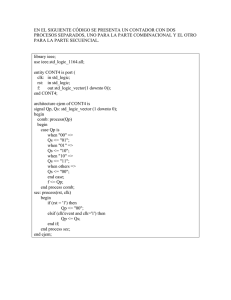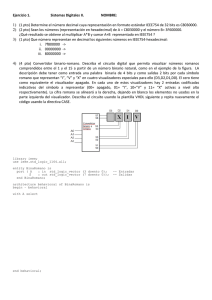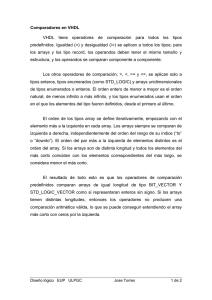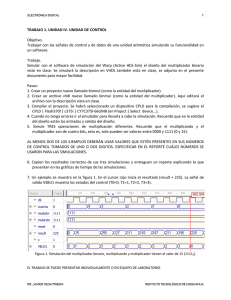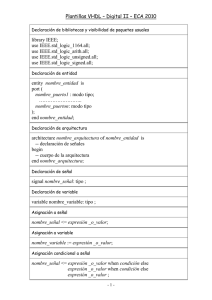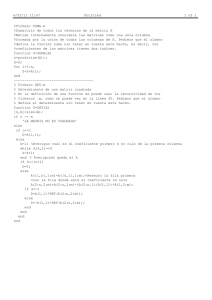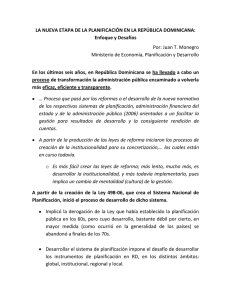Laboratorio 3: Diseño Digital Elver Yoel OCMIN GRANDEZ
Anuncio
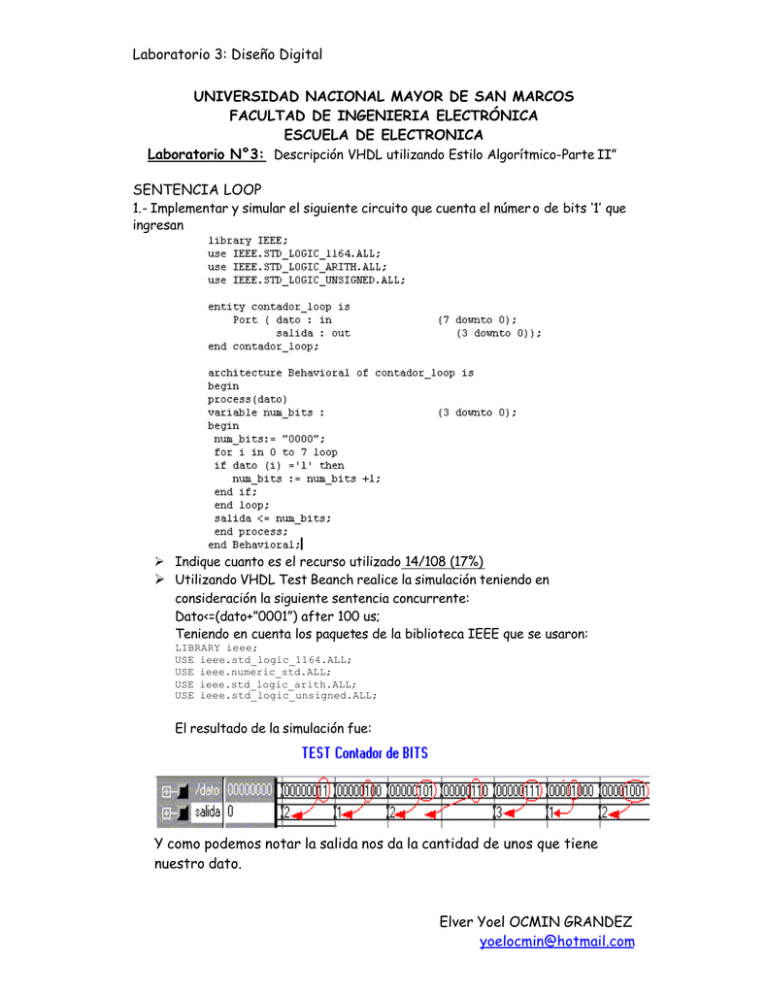
Laboratorio 3: Diseño Digital UNIVERSIDAD NACIONAL MAYOR DE SAN MARCOS FACULTAD DE INGENIERIA ELECTRÓNICA ESCUELA DE ELECTRONICA Laboratorio N°3: Descripción VHDL utilizando Estilo Algorítmico-Parte II” SENTENCIA LOOP 1.- Implementar y simular el siguiente circuito que cuenta el númer o de bits ‘1’ que ingresan Ø Indique cuanto es el recurso utilizado 14/108 (17%) Ø Utilizando VHDL Test Beanch realice la simulación teniendo en consideración la siguiente sentencia concurrente: Dato<=(dato+”0001”) after 100 us; Teniendo en cuenta los paquetes de la biblioteca IEEE que se usaron: LIBRARY ieee; USE ieee.std_logic_1164.ALL; USE ieee.numeric_std.ALL; USE ieee.std_logic_arith.ALL; USE ieee.std_logic_unsigned.ALL; El resultado de la simulación fue: Y como podemos notar la salida nos da la cantidad de unos que tiene nuestro dato. Elver Yoel OCMIN GRANDEZ [email protected] Laboratorio 3: Diseño Digital Ø Modificar el programa para que el circuito contador de bits ‘1’ aumente el número de entradas de 8 a 16 bits. Ø Indique cuanto es el porcentaje de recurso utilizado 32 /108 (29%) DESCRIPICION DE MAQUINA DE ESTADO A) ESTILO EXPLICITO E1: 2.- Implemente y simule la siguiente maquina de estado utilizando el estilo explicito E1. library IEEE; use IEEE.STD_LOGIC_1164.ALL; use IEEE.STD_LOGIC_ARITH.ALL; use IEEE.STD_LOGIC_UNSIGNED.ALL; entity MEF1 is Port ( reloj : in std_logic; reset : in std_logic; x : in std_logic; z : out std_logic); end MEF1; architecture Behavioral of MEF1 is type estados is (S0,S1,S2,S3); signal estado : estados ; signal ntx_estado : estados ; begin combinacional: process(estado; x) begin ntx_estado <= estado ; case estado is when S0 => z<= '0'; if (x='0) then ntx_estado <= S1; else ntx_estado <= S2; end if; end Behavioral; Elver Yoel OCMIN GRANDEZ [email protected] Laboratorio 3: Diseño Digital Ø ¿La descripción de la arquitectura coincide con el flujo seguido en el diagrama de estado? Rspta: SI Ø Indique cuanto es el porcentaje del recurso utilizado 3/108 (2%) Ø UtilizandoTest Beanch Wave Form realice la simulación del circuito teniendo en consideración los siguientes valores de entrada....... .......Se simulo y los resultado fueron tal y como se vio en la guia del laboratorio, y por considerar que estaban demás repetirlos, no pongo los resultados nuevamente.......... B) ESTILO EXPLICITO E2: 3.- Implemente y simule la siguiente maquina library IEEE; use IEEE.STD_LOGIC_1164.ALL; use IEEE.STD_LOGIC_ARITH.ALL; use IEEE.STD_LOGIC_UNSIGNED.ALL; entity MEF2 is Port ( RELOJ,RESET : in std_logic; X : in std_logic; Z : out std_logic); end MEF2; architecture algoritmo of MEF2 is type estados is(S0,S1,S2,S3); begin secuencial:process variable estado:estados; begin wait until reloj='1'; if(reset='0')then estado:=S0; else case estado is when S0=>Z<='0';if(x='0') then estado:=S1; else estado:=S2;end if; when S1=>Z<=X;estado:=S0; when S2=>Z<='0';if(x='0') then estado:=S1; else estado:=S3;end if; when S3=>Z<='0';if(x='1') then estado:=S1; end if; end case; end if; end process secuencial; end algoritmo; 4.- (TRABAJO) Implementar un decodificador de teclado maatricial 4x4. Utilice MEF. Sol Desarrollare el Problema 1 del examen, ya que a parte de ser un decodificador de teclado matricial, su enunciado esta mejor explicado. Elver Yoel OCMIN GRANDEZ [email protected] Laboratorio 3: Diseño Digital PROB.- Se desea diseñar un circuito detector de teclado matricial 4x4. El circuito a implementar debe generar una secuencia por los pines de la columna C[4...1] como se muestra en la figura adjunta. Cada secuencia debe generarse ca da 5 ms aprox. Si no se ha pulsado ninguna tecla los datos que se leen n las filas F[4...1] es “1111”. Si se pulsa una tecla debe codificarla de acuerdo al dato que ingresa por las filas de acuerdo a la tabla. Además la señal DV(dato valido) debe activarse 5 ms aprox. NOTA: La señal de reloj que llega al CPLD es de 1 MHz. TABLA DE CONVERSIÓN TECLADO4x4 C4 C3 C2 C1 F4 F3 F2 F1 CARACTER 1 1 1 1 1 1 1 1 1 1 1 1 0 0 0 0 1 1 1 1 1 1 1 1 0 0 0 0 1 1 1 1 1 1 1 1 0 0 0 0 1 1 1 1 1 1 1 1 0 0 0 0 1 1 1 1 1 1 1 1 1 1 1 1 1 1 1 0 1 1 1 0 1 1 1 0 1 1 1 0 1 1 0 1 1 1 0 1 1 1 0 1 1 1 0 1 1 0 1 1 1 0 1 1 1 0 1 1 1 0 1 1 0 1 1 1 0 1 1 1 0 1 1 1 0 1 1 1 A=1010 B=1011 C=1100 F=1111 3=0011 6=0110 9=1001 E=1110 2=0010 5=0101 8=1000 0=0000 1=0001 4=0100 7=0111 D=1101 Elver Yoel OCMIN GRANDEZ [email protected] Laboratorio 3: Diseño Digital Solucion: Para resolver este ejercicio, lo voy a descomponer en 2 partes, cada una de ellas son procesos concurrentes, Asi que lo voy a trabajar como si fueran dos maquinas separadas. 1ra maquina: Esta va a ser la encargada de generarme la secuencia en C[4...0], y que cada una de estas secuencias dure 5 ms; C va alternar en los valores ‘1110’, ’1101’, ’1011’ y ‘0111’, nuestra secuencia seguira el siguiente diagrama de estados: Y para su más facíl codificación lo hacemos con el estilo MEF-E2: Hasta ahora su codificación seria. library IEEE; use IEEE.STD_LOGIC_1164.ALL; use IEEE.STD_LOGIC_ARITH.ALL; use IEEE.STD_LOGIC_UNSIGNED.ALL; entity secuencia is Port ( Clk : in bit; C : out std_logic_vector(3 downto 0)); end secuencia; architecture algoritmo of secuencia is signal rstcnt,rstcnt0,rstcnt1,rstcnt2,rstcnt3:boolean:=true; signal cnt,cnt0,cnt1,cnt2,cnt3:integer:=0; begin secuencia: process type estados is(C0,C1,C2,C3); variable estado:estados:=C0; begin wait until clk='1'and clk'event; case estado is when C0=>C<="1110"; if(cnt0>=5000) then estado:=C1;rstcnt0<=true;rstcnt1<=true; else rstcnt0<=false;estado:=C0;end if; when C1=>C<="1101"; if(cnt1>=5000) then estado:=C2;rstcnt1<=true;rstcnt2<=true; else rstcnt1<=false;estado:=C1;end if; when C2=>C<="1011"; if(cnt2>=5000) then estado:=C3;rstcnt2<=true;rstcnt3<=true; else rstcnt2<=false;estado:=C2;end if; when C3=>C<="0111"; if(cnt3>=5000) then estado:=C0;rstcnt3<=true;rstcnt0<=true; else rstcnt3<=false;estado:=C3;end if; end case; end process secuencia; Elver Yoel OCMIN GRANDEZ [email protected] Laboratorio 3: Diseño Digital contador: process begin wait until Clk='1'and clk'event; if rstcnt0 then cnt0<=0;else cnt0<=cnt0+1;end if rstcnt1 then cnt1<=0;else cnt1<=cnt1+1;end if rstcnt2 then cnt2<=0;else cnt2<=cnt2+1;end if rstcnt3 then cnt3<=0;else cnt3<=cnt3+1;end end process contador; end algoritmo; if; if; if; if; Y su simulacion seria : Donde la parte ensobrecida es cuando los contadores cuentan 5000 c/u, para asi, genera secuencia después de cada 5 ms; Hasta ahora tenemos la secuencia, pero nos falta la tabla de conversión, o mejor dicho, la maquina que nos diga que teclas se presiono. Esta maquina tiene mas o menos el siguiente diagrama de estado: y la codificación total de esta maquina y la secuencial seria: library IEEE; use IEEE.STD_LOGIC_1164.ALL; use IEEE.STD_LOGIC_ARITH.ALL; use IEEE.STD_LOGIC_UNSIGNED.ALL; entity teclado is Port ( Clk : in bit; C : buffer std_logic_vector(3 downto 0); F: in std_logic_vector(3 downto 0); D: out std_logic_vector(3 downto 0); DV: out std_logic); end teclado; Elver Yoel OCMIN GRANDEZ [email protected] Laboratorio 3: Diseño Digital architecture algoritmo of teclado is signal rstcnt,rstcnt0,rstcnt1,rstcnt2,rstcnt3:boolean:=true; signal cnt,cnt0,cnt1,cnt2,cnt3:integer:=0; begin secuencia: process type estados is(C0,C1,C2,C3); variable estado:estados:=C0; begin wait until clk='1'and clk'event; case estado is when C0=>C<="1110"; if(cnt0>=5000) then estado:=C1;rstcnt0 <=true;rstcnt1<=true; else rstcnt0<=false;estado:=C0;end if; when C1=>C<="1101"; if(cnt1>=5000) then estado:=C2;rstcnt1<=true;rstcnt2<=true; else rstcnt1<=false;estado:=C1;end if; when C2=>C<="1011"; if(cnt2>=5000) then estado:=C3;rstcnt2<=true;rstcnt3<=true; else rstcnt2<=false;estado:=C2;end if; when C3=>C<="0111"; if(cnt3>=5000) then estado:=C0;rstcnt3<=true;rstcnt0<=true; else rstcnt3<=false;estado:=C3;end if; end case; end process secuencia; tabla: process(F) type estadostab is (T0,T1,T2); variable tab:estadostab:=t0; variable t: std_logic_vector(7 downto 0); begin T:=C&F; primer: case tab is when T0 =>if(F="1111") then rstcnt<=true; else tab:=T1;rstcnt<=false;end if;DV<='0'; when T1 =>if(cnt>=5000) then rstcnt<=true;DV<='0';tab:=T2; else segundo :case T is when "11101110"=>D<="1010";DV<='1';- -A=”E&E” when "11101101"=>D<="1011";DV<='1';- -B=”E&D” when "11101011"=>D<="1100";DV<='1';- -C=”E&B” when "11100111"=>D<="1111";DV<='1';- -F=”E&7” when "11011110"=>D<="0011";DV<='1';- -3=”D&E” when "11011101"=>D<="0110";DV<='1';- -6=”D&D” when "11011011"=>D<="1001";DV<='1';- -9=”D&B” when "11010111"=>D<="1110";DV<='1';- -E=”D&7” when "10111110"=>D<="0010";DV<='1';- -2=”B&E” when "10111101"=>D<="0101";DV<='1';- -5=”B&D” when "10111011"=>D<="1000";DV<='1'; - -8=”B&B” when "10110111"=>D<="0000";DV<='1';- -0=”B&7” when "01111110"=>D<="0001";DV<='1';- -1=”7&E” when "01111101"=>D<="0100";DV<='1';- -4=”7&D” when "01111011"=>D<="0111";DV<='1';- -7=”7&B” when "01110111"=>D<="1101";DV<='1';- -D=”7&7” when others=>D<="XXXX";DV<='0'; end case segundo; end if; when T2=>DV<='0';tab:=T0; end case primer; end process tabla; contador: process begin wait until Clk='1'and clk'event; if rstcnt0 then cnt0<=0;else cnt0<=cnt0+1;end if rstcnt1 then cnt1<=0;else cnt1<=cnt1+1;end if rstcnt2 then cnt2<=0;else cnt2<=cnt2+1;end if rstcnt3 then cnt3<=0;else cnt3<=cnt3+1;end end process contador; end algoritmo; if; if; if; if; Elver Yoel OCMIN GRANDEZ [email protected] Laboratorio 3: Diseño Digital Y su simulación en el test-Beanch lo hice teniendo en cuenta: clk<=not clk after 500 ns; --//reloj de 1 us f<="1111","1011"after 6 ms,"1110"after 12 ms,"0111"after 17 ms,"1111"after 20 ms,"1110"after 24 ms,"1011"after 30 ms,"1110"after 36 ms,"1011"after 42 ms,"1011"after 50 ms,"1110"after 55 ms,"1011"aft er 60 ms; y la respuesta a la simulacion fue: Donde podemos comprobar: En a: D&B = 9 En b: B&E = 2 En c: 7&7 = D En d: F-> no hay dato, no se presiono tecla En e: E&E =A En f: D&B=9 En g: 7&E=1 En h: E&B=C En i: B&E=2 5.-(TRABAJO) Implementar un circuito para detectar la siguiente secuencia: 1 0 1 1 (Considere Traslape). La salida Z normalmente es ‘0’ y se activa cuando se detecta secuencia. Ø Utilice el estilo MEF-E1 Su diagrama de estado seria: Donde los estados son: S0:Cuando detecta el 1er numero, si encuentra al ‘1’ pasa a S1, sino sigue esperando. S1:tiene un 1 y espera ahora un 0, para tener ahora ‘10’ si lo encuentra pasa a S2, en caso de que no lo encuentre se queda ahí, ya que tendria un 11X- y si x=0, tendría parte de la serie en 110- tendría 10. Elver Yoel OCMIN GRANDEZ [email protected] Laboratorio 3: Diseño Digital S2:Espera un 1 para tener “101”, en caso de no tenerlo regresa a S0, ya que tendría 00X- y no le sirve. S3:Espera un 1 para completar su serie “1011”, en caso de no hacerlo tendría “1010” y le conviene regresar a S2 y esperar un “11” para terminar serie S4:Ya completo la serie, ahora z lo pone a 1 y regresa a S0; El programa seria: library IEEE; use IEEE.STD_LOGIC_1164.ALL; use IEEE.STD_LOGIC_ARITH.ALL; use IEEE.STD_LOGIC_UNSIGNED.ALL; entity sec1011_E1 is Port (clk,data:in std_logic; z:out std_logic); end sec1011_E1; architecture Behavioral of sec1011_E1 is type estados is(S0,S1,S2,S3,S4); SIGNAL ESTADO:ESTADOS:=S0; signal nxt_estado:estados:=S0; begin combinac: process(estado,data) begin nxt_estado<=estado; case estado is when S0=>Z<='0'; if(data='1') then nxt_estado<=S1;end if; when S1=> Z<='0'; if(data='0') then nxt_estado<=S2;end if; when S2=> Z<='0'; if(data='1') then nxt_estado<=S3; else nxt_estado<=S0;end if; when S3=> z<='0'; if(data='1') then nxt_estado<=S4; else nxt_estado<=S2;z<='0';end if; when S4=>z<='1'; if(data='0') then nxt_estado<=S0; else nxt_estado<=S1;end if; end case; end process combinac; secuencial:process(clk) begin if(clk'event and clk='1') then estado<=nxt_estado; end if; end process secuencial; end Behavioral; La simulación con el Test Beanch WaveForm: Z es 1 cuando han pasado sus estados por S0 ,S1,S2,S3,S4 y ha reconocido que hubo la señal “1011” y en S4 pasa Z a ‘1’ Elver Yoel OCMIN GRANDEZ [email protected] Laboratorio 3: Diseño Digital Ø Utilice el estilo MEF-E2:Nuestro diagrama de estado es: Y la programación seria: library IEEE; use IEEE.STD_LOGIC_1164.ALL; use IEEE.STD_LOGIC_ARITH.ALL; use IEEE.STD_LOGIC_UNSIGNED.ALL; entity sec1011_E2 is Port (clk,data:in std_logic; z:out std_logic); end sec1011_E2; architecture Behavioral of sec1011_E2 type estados is(S0,S1,S2,S3,S4); begin secuencial: process variable estado:estados:=S0; begin wait until clk='1'; case estado is when S0=>Z<='0'; if(data='1') then when S1=> Z<='0'; if(data='0') then when S2=> Z<='0'; if(data='1') then when S3=> Z<='0'; if(data='1') then when S4=> Z<='1'; if(data='1') then end case; end process secuencial; end Behavioral; is estado:=S1;end if; estado:=S2;end if; estado:=S3;else estado:=S0;end if; estado:=S4;else estado:=S2;end if; estado:=S1;else estado:=S4;end if; Y su simulación con el Test Beanch WaveForm : Elver Yoel OCMIN GRANDEZ [email protected]
